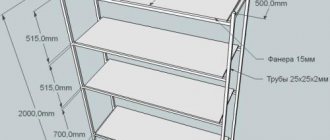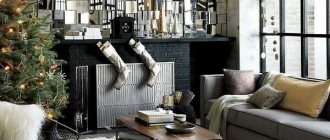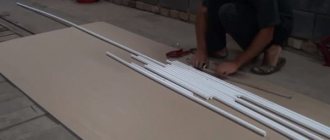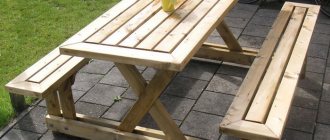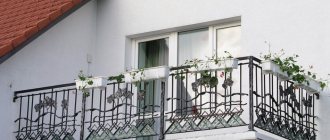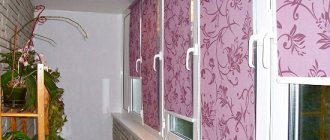Home / Interior
Back
Reading time: 3 min
0
4
Those who plan to build a country house think about the following questions: is a balcony needed in a private house, how should it be made? Such an extension is definitely necessary, since it provides many “advantages”, although its construction is an additional cost. It’s best to include it immediately in the project, it will be easier. But even if you bought a house without a balcony, it doesn’t matter - you can always add one, and not just one, but several.
- 1 What are the benefits of a balcony?
- 2 What types of balconies are there?
- 3 Concrete balcony: reliable and durable
- 4 Beautiful brickwork
- 5 Natural material – wood
- 6 Exquisite forging
Balcony in a private house: main points to consider when arranging it
The debate about whether a balcony is needed in a country house in Central Russian and more northern regions has been going on for many years. Both supporters and opponents of this architectural element make compelling arguments. Trying to maintain neutrality, we will talk about how to avoid mistakes when building a balcony, make it “habitable” and easy to use.
In wooden buildings, the support for the balcony can be the extensions of several logs (beams) of the internal walls. Such consoles are very reliable and also decorate the building. Photo: MOLLES
We create decor for a small room with a seating area
To get a real art balcony, you just need to try a little and use all your imagination. The area of such a room is small, but you should fit a maximum of things into it that will help create a cozy environment for a pleasant stay.
For example, a modern art balcony may contain a sofa that is made from the most common wooden pallets. As the best decoration, you need to put a lot of pillows of different colors on it. If there are no bookshelves above the sofa, then you should hang them. The shelves should be small so that they do not take up much space.
READ MORE: How to make an office from a balcony
It is best when the art balcony is designed in a fairly popular style today - minimalism. To do this, you need to use decorative elements of light shades as a complement: vases or figurines made of wood.
Such an interesting and simple art balcony with a seating area will become even more comfortable if the most ordinary packed wooden boxes are used as convenient shelves where you can put your favorite books.
Balcony or loggia?
When it comes to cottage development, the terms “balcony” and “loggia” are often confused, since the definitions given by building regulations apply to multi-storey buildings. In general, it is generally accepted that a loggia, unlike a balcony, does not protrude beyond the plane of the wall of the floor below. The base of the loggia floor, as a rule, is the interfloor ceiling, and the lower frame of the balcony rests on pillars (columns) and/or consoles - specially designed outlets of slabs or floor beams.
In low-rise buildings with a pitched roof, a balcony or loggia is especially appropriate on one of the main facades, where they will be protected from precipitation by a gable overhang.
Another popular option is a gallery balcony along the side facade.
Sometimes on the attic floor, when constructing a loggia, an opening is made in the roof slope. Such projects are suitable only for warm regions with snowless winters. In the conditions of central Russia, the room will have to be covered with a canopy, which is unlikely to decorate the building and, moreover, will complicate the removal of snow from the roof. In the absence of a canopy, after each snowfall, snowdrifts will grow on the floor of the loggia.
Photo: IZBA De Luxe
Balcony (loggia) in a country house
| Advantages | Flaws |
| Decorates the building, giving the facades volume and expressiveness. | The loggia is used only sporadically, and in many cases its construction is associated with a reduction in the area of one of the living rooms. |
| The spacious balcony can be used as a summer terrace. The advantage of the upper location is the view of the surrounding area. | In winter, the balcony is often covered with snow, in summer it can be too hot, and in rainy weather the floor gets wet and becomes slippery. |
| It can provide an additional emergency escape route from the building, especially if you provide a hatch in the floor and stock up on a folding ladder. | Without regular (every 2-3 years) treatment, over time the railings and, what is much worse, the support beams and posts begin to rot. |
Balcony fencing is usually made 90–110 cm high, the distance between baluster posts should not exceed 150 mm. Photo: Vladimir Grigoriev/Burda Media
Advantages and disadvantages of a balcony in a private house
The main advantages of building balconies in a country house include:
- availability of additional space
- better room lighting
- increased functionality
- aesthetic side - the balcony gives the house elegance and sophistication
At the same time, experts recommend not building balconies in houses with limited space, which are intended for a small family. It is also better to refuse a balcony if the building is located on a free and large plot. In this case, it is better to make a choice in favor of open terraces on the ground floor.
The disadvantages of building a balcony include the financial side of the issue - this event is quite expensive, which requires the use of high-quality materials, beautiful external and internal design. From time to time you can see unfinished balconies that spoil the appearance of the house for years and serve as a useless pantry or storage space.
Preventive measures when arranging a balcony
When designing a building, first of all, you need to ensure that the balcony (loggia) is protected from rain, snow and summer heat. Otherwise, there is a risk that you will use it for recreation infrequently, but the hassle of maintaining the building will noticeably increase: in winter you will have to remove snow, and in summer you will have to renew the finish that has been damaged by moisture and sun.
Orientation to the cardinal points. Ideally, the balcony should face east or southeast. Then it will be sheltered from damp and cold western and northern winds, well lit in the morning and protected from the midday summer sun. Alas, in the conditions of village development, it is not always possible to orient a building in the required way.
Roof. A canopy should be provided above the balcony or the roof overhang should be increased. In this case, the cornice should protrude beyond the plane of the balcony railing by at least 40 cm. The wide overhang is supported by pillars, and in the male roof its basis is the outlets.
Bearing structures. When installing ceilings and cantilever supports, it is desirable to avoid extended cold bridges between the street and the room. From this point of view, in a stone house, external reinforced concrete beams are preferable to a slab pinched by a wall.
A balcony that protrudes beyond the plane of the wall by more than 1.5 m usually has to be supported by pillars (columns), which transfer the load to the foundation of the house. It is also possible to install independent drilled or screw piles under the columns below the soil freezing depth.
Photo: IZBA De Luxe
A lightweight balcony with a projection of no more than 1 m can be “hung” on the facade using decorative forged brackets, which are attached to the wall using embedded elements or studs through through holes (anchors and cap screws in this case are not reliable enough).
During construction, wooden consoles and beams of the lower railing of the balcony should be treated with an antiseptic 2-3 times and only then painted. Steel beams are protected from rust with bitumen varnish or paint with anti-corrosion additives; forged brackets are best coated with powder enamel or artificial patina. A cement-polymer or bitumen-polymer water-repellent composition is applied to load-bearing concrete elements.
Floor construction. When choosing it, it is important to take care of the drainage of rain and melt water, which should be drained according to the same principle as from the roof: flow through a drip into the gutter and then into the drainpipe.
When installing decking, hidden fasteners are used. Photo: TermoWood
If the base of the floor is a concrete slab, then you can pour a cement-sand screed on top of it with a slope of about 2% from the house, and lay a waterproof coating on it, for example, clinker or porcelain tiles.
The floor covering for the balcony must have anti-slip properties and resistance to moisture and ultraviolet radiation.
Another option is a double floor covered with decking boards on joists. The logs must last at least 15 years, so for them you should choose larch or wood impregnated with an antiseptic under pressure (impregnated). The most durable logs are aluminum, but they cost from 800 rubles. for 1 linear m. You should not lay an ordinary planed board on the balcony: it is too smooth and, when wet, becomes slippery, especially if the wood is infected with fungus. It is better to choose decking made of larch or wood-polymer composite.
The joists are leveled using plastic support wedges and secured with galvanized steel plates. Photo: Terradek
Railing. The fencing structure must withstand a horizontal load of at least 150 kgf/m applied to the handrail. A solid (screen) fence should be supported by a horizontal beam, which is installed at a distance of at least 5 cm from the floor using spacers. This gap is necessary for water drainage; with a smaller value, it will become clogged with leaves in the fall, and with ice in the cold season.
Photo: Moscow Forging
How to decorate a balcony with flowers: compositional design
Let's move on to the compositional design of plants for balconies. It must be said that when placing flowers and plants in balcony boxes, it is extremely important not to overdo it with a variety of colors. Ideally, the composition should consist of no more than two colors that harmonize well with each other. Thus, beautifully and laconically planted monochromatic red pelargoniums, amazingly beautiful fuchsia or salvia, beautiful pink petunias and white daisies will arouse admiration among your friends and acquaintances, as well as ordinary passers-by who will not be able to pass by such indescribable beauty.
It should be remembered that some plants are good only in planting of the same type (for example, purslane and gatsaniya, godetia, dahlias, Erica and dimorphotheca, as well as asters and chrysanthemums).
Pay attention to drawers, flower pots, and pots. Ideally, they should be made in the same style or color.
Pots and boxes with a wicker texture or imitation stone are great for oasis balconies.
Leading manufacturers of accessories for growing plants sell special containers for balcony plants. Such are, for example, flowerpot boxes from lechuza, equipped with special balcony mounts. This is not the only reason why we mentioned the lechuza brand. The fact is that their flower pots and boxes are called “smart”, because... they are equipped with an automatic watering system, which is very convenient if there are a lot of plants on the balcony and there is no time to water them.
If you want to turn a balcony or loggia into a garden or flower garden , you can at least buy one or several lechuza flowerpots for the most “moisture-dependent plants” as a test. By the way, if there is a lack of humidity on a glazed balcony, veranda, or loggia, purchase an air humidifier. Run it with the windows closed.
Additional options for the balcony
Marquise
A balcony facing south or southwest can be shaded in summer using a folding awning - an awning. The most popular are elbow models, which are folded out with two or more composite levers. When folded, the awning is rolled up and hidden under the visor or in a cassette. It should be noted that the structure is afraid of strong winds, and in the event of a storm warning it must be urgently folded. It’s even better to equip the mechanism with an electric drive with a wind sensor. The price of an elbow awning with an area of 3 m2 with a manual drive is from 13 thousand rubles, for an electric drive and automation you will have to pay about another 10 thousand rubles. (excluding installation work).
An elbow cassette awning with an aluminum alloy frame and a polyacrylic fabric panel will last at least 10 years, but only if you thoroughly dry the fabric before putting it in the cassette and promptly service the mechanism. Photo: Sunforce
Anti-icing system
Precipitation somehow ends up on the balcony, and during the cold season ice often forms on the floor. An electrical heating system for open areas, for example Freezstop Patio (“SST”) or xBeamer (Caleo), will help to cope with it, consisting of heating elements (resistive cable or rods) and control equipment (relay regulators, water sensors, temperature and air humidity, protective devices). Heating elements are embedded in a concrete screed or a layer of glue under stone and ceramic coverings.
The cost of an electric anti-icing system for a site of 3.5–4.5 m2 (cable length 37 m) starts from 16 thousand rubles. Photo: SST
How to correct mistakes on a finished balcony
If you purchased a house with the “wrong” balcony or previously made mistakes during the design, do not despair - many problems can be solved after the construction of the house is completed.
If there is no roof over the balcony, it is not difficult to mount a transparent or translucent canopy that will fit into the appearance of the facade. The most durable products are made from monolithic polycarbonate with an aluminum frame. Canopies made of cellular polycarbonate on steel brackets are cheaper, but less reliable. Standard products with an area of 100 cm (extension) × 150 cm (width) are sold in construction hypermarkets for 3800–4500 rubles. They can be installed in a row, sealing the joints with roofing sealant. A visor of other sizes will be made in a specialized workshop.
If there is a roof over the balcony, but it is still covered with snow, it is worth purchasing so-called soft windows - curtains made of PVC film with zippers that allow you to tightly close the facade of the balcony. They are very easy to install, and you can remove them in the spring in a matter of minutes. The price of “soft windows” is from 2800 rubles. for 1 m 2.
Communities › Construction (and everything connected with it) › Blog › DIY balcony in a private house
Hi all. We built ourselves a house in the village and have been living in it for more than four years. Initially they planned to make a balcony in the house, during construction the beams were released, the floor was laid and that’s it, so it lived for four years and I began to worry about the beams, they are wooden. This year I took a vacation and decided to make a canopy over the balcony so that the beams would not rot, and then away we go... look at the photos and captions for them.
This is how we made a canopy over the balcony))) All the work was carried out by: I am the main builder and designer; The wife is the main painter; Children aged 13 and 10 are apprentices...
Everything took a week and a half and about 15,000 rubles (balusters are not included in this amount - we waited in the wings for 4 years). All that remains is to nail the plinth along the wall and the trim on the windows, and to decorate the lower outer part of the balcony and part of the pediment above it.
All the best and see you again.
Design of balconies in private houses
There are two main methods of constructing balconies in country houses - remote and built-in.
Remote, open balconies are a relatively simple option in design and execution, on a reinforced concrete slab or beams (wood, metal). The remote balcony is in no way connected either to the roof or to the premises of the first floor; it has its own load-bearing frame. Although the open type does not create any special problems with waterproofing (slope, drips), if mistakes are made, water leaks will deteriorate the façade.
In addition, do not forget about the snow load.
DiJoForumHouse Member
If you don’t clean it regularly in winter, so much snow can accumulate on the balcony that it simply collapses. Here near St. Petersburg, this winter (every seven years we have such winters), a meter of snow piled up on flat roofs and balconies, many of them were “somewhat spoiled.” Moreover, it caked and got wet. And a layer of snow 2x1x1 m weighs more than a ton.
Built-in balconies are built above the premises of the first floor; these can be either residential, heated rooms, or cold verandas, terraces, vestibules or porches. An unheated room is preferable, since it is easier to waterproof when there are no warm fumes rising upward. And in the event of a serious leak during rain or snow melt, there is no danger of having to fill in expensive repairs.
For the most part, built-in balconies in private houses are more like loggias, since they are closed both on the sides and on top, which, however, does not completely prevent problems during operation.
FortunaForumHouse Member
Whether a balcony is needed or not, everyone decides for themselves. My house looks like my avatar. Two full floors and it turned out to be two loggias. The floors are constantly wet from the rain. This year I want to sew up the bottom one flush with the house (to make a hallway), and glaze the top one. A balcony in a wooden house is good, but tedious to use.
Tags: balcony, house, canopy, village, balusters
Comments 46
I didn't understand. Did you put a VAPOR PROOF on the OUTSIDE, on top of the insulation? If you didn’t make a reservation, take it apart urgently, vapor barrier can only be installed from the inside. On the outside there are only windproof membranes.
and how to properly insulate a house using logs?
Vapor barrier on the inside, wind protection on the outside. Add. insulation - according to calculation, either between the PI and the beam, or between the beam and the VZ. If you use EPS as insulation, then only from the inside. Internal vapor barrier may not be necessary; calculations are also needed. wind protection is needed if the insulation is outside; If there is timber on the outside, but it is well caulked, then windproofing will not give a noticeable improvement. The only thing that is absolutely without any calculation is that there should be no vapor barrier on the outside.
I want to insulate the outside with cotton wool, how to correctly position the vapor barrier which side goes where?
Vapor barrier has no sides, membranes have sides. Which side to place the membrane on is indicated in the instructions; instructions are usually either on the package or included.
Although, I once saw a vapor barrier, but with pile on one side - it is placed with the pile facing the room, so that condensation, if it falls, does not flow down in puddles, but remains on the pile until it dries. I'm not sure there's any real benefit to this.
This is exactly how it works, the vapor barrier allows moisture to pass through only in one direction, just from the pile side to the smooth side and prevents moisture from penetrating into the room...
It is the membrane that allows it to pass through. The vapor barrier doesn't let anything in. The best vapor barrier in terms of price/quality ratio is a two-hundred-micron polyethylene film; Americans mainly use it.
And further. The membrane (placed outside) prevents moisture from penetrating into the insulation. A vapor barrier (installed from the inside) prevents moisture from entering the insulation from the room. In winter, there is approximately ten times more water in a cubic meter of indoor air than in outdoor air.
Perhaps I wrote it wrong, but I have a membrane that prevents moisture from getting into the insulation from the outside.
It's good if so)))
It turned out great. Right now I’m going through the same process, only there’s a board on the floor and three layers of texturel and wax.
Thank you. Good luck with your build.
Is the siding faded or couldn’t you match the color?
It also seems to say that the inside was made with clapboards and painted with acrylic paint (and the siding on the outside) - when tinted, the color was similar, but when it dried, the shade began to differ - I think this is not critical...
It doesn’t hurt to install supports under the balcony - you never know when the tree will rot and break.
there are plans, but not for this year...
you also need a table, chairs and a cup of hot coffee with your beloved to admire the sunset
samovar and a bunch of dryers on the wall
samovar and a bunch of dryers on the wall
...and stretch the dried roach on a rope along the balcony)))
you also need a table, chairs and a cup of hot coffee with your beloved to admire the sunset
There will be a table, but not this season - it’s already cold
How are the railings and balusters attached to them? Do you have a photo? Otherwise I’ll make a porch-gazebo
I placed 50x25mm bars at the top and bottom of the balusters and screwed the balusters through them, and then also screwed the railings on top of the block (through the block from bottom to top). I installed the lower bars on short blocks so that water could flow freely from the balcony. Take a closer look - these bars are clearly visible in the last photo.
Is there a way to attach railings without corners? I didn’t know?
there is, but then you will have to fasten it immediately when installing the racks on the tenons, or make balusters at the very edges (or additional blocks) that are attached to the racks, and the railings are already attached to them. You can also fasten it diagonally to the stand with long self-tapping screws, through a pre-drilled hole - for example, from the bottom up and diagonally, so that it is not noticeable, or from the top down and deepen it a little, and then fill the recess with wood fillers... in short, there are a lot of options - I chose the simplest one, but not the most beautiful, but when the corners are painted over, they don’t really catch the eye...
Is there a way to attach railings without corners? I didn’t know?
tenon/groove, or dowels - all this must be glued! (it will be more reliable than on the corners)
Wouldn't it be worse for unprotected sockets on the balcony?
I would plug in IP55/IP56 (those with flaps). Anything is more reliable!
I plugged in what was there - maybe I’ll replace it later, but I made the outlet switchable from home (via a switch), that is, when it’s not needed, there’s no phase on it...
Wouldn't it be worse for unprotected sockets on the balcony?
It is connected via a switch and its holes themselves are protected, although perhaps I will replace it in the future... - in short, time will tell, but I installed one - it was just in stock. Well, there is real “earth” connected to it and an RCD is installed in the house - so if anything doesn’t kill)))
Socket covers are now in trend, but it makes sense to install IP65 on a metal substrate, because... siding, as far as I remember, is flammable... “... an RCD is installed...” is this one RCD at the input or is it several on the group lines, or both combined?
one at the entrance to the house (3-phase), works perfectly - tested several times)))
Socket covers are now in trend, but it makes sense to install IP65 on a metal substrate, because... siding, as far as I remember, is flammable... “... an RCD is installed...” is this one RCD at the input or is it several on the group lines, or both combined?
Well, the socket is switchable, there is a switch in the house and when it is not needed there is no phase on it, I will turn it on only when necessary, which happens 2-3 times a year and then in the summer...
Open balcony in a private house
Balconies and loggias are integral elements of modern residential buildings. When properly designed, they become an excellent place for a comfortable rest, exciting pastime, conversations, and romantic evenings. The selection of finishing materials, furniture, accessories, the use of design techniques - all this helps to create the necessary atmosphere, regardless of the size of the available space.
Where does the redesign of an open balcony begin?
The process of decorating a balcony space should begin with a thorough cleaning of the area and assessing the condition of the facade. Cleaning involves removing unnecessary, old things. Inspection of the facade is necessary so that after completion of the work, the pastime will be comfortable and cozy. Therefore, if there are defects, it is advisable to eliminate them during the re-registration procedure.
The scheme of subsequent actions is determined by the type of balcony structure. The most commonly used concrete systems are characterized by high strength, durability, and endurance. But wooden systems are also often found, in particular in houses built from such material. When professionally performed, they have equally impressive characteristics.
The canopy also requires attention, without which it is difficult to imagine an open balcony. Since the presence of a visor provides protection from rain, bad weather, and hot sun. It must be larger than the balcony itself and installed at a certain angle.
Disadvantages of building a balcony
If everything is clear with the advantages, then with the disadvantages of building a balcony in a house made of timber, not everything is so obvious, we will consider them below:
- Heat loss. A balcony is another door in the house, which entails increased heat loss and the need for additional insulation.
- Complexity of design and construction. The balcony is one of the most difficult parts of the house. Even small mistakes during the construction of a balcony can lead to serious consequences. Due to the complexity of construction, a balcony is also one of the most expensive elements in the house.
- Need for further care. The balcony will need to be looked after, tinted and treated with wooden surfaces during use.
In any case, it is up to the customer to decide whether to choose a timber house project with or without a balcony. A balcony can become a real decoration of the house, but its construction is associated with certain costs.
The importance of choosing the right materials
Attractive balconies can be designed both in an apartment and in a country house. Of course, there are many more possibilities in cottages. But even a small area can be made as functional and ergonomic as possible. In any case, the final result will depend on the selection of building materials.
These must be products designed for use in harsh conditions, able to withstand temperature changes, moisture, and exposure to sunlight. Building materials that will be used for work on the south, sunny side require special attention. They must be resistant to fading and ultraviolet radiation.
Flooring options for an open balcony
When decorating an open balcony, it is important to install the flooring correctly. The durability and attractiveness of the finish in the future largely depends on this. Regardless of where the work will be carried out - in a country house or in an apartment, it is recommended to ensure a slight slope of the base.
It may be completely invisible, but it will avoid the accumulation of moisture and subsequent destruction of the coating. As a base, it is recommended to make a screed that is suitable for further installation of almost any material. Sometimes design features require searching for other solutions.
Among the finishing options used, the best characteristics are:
- Porcelain stoneware is an incredibly strong and durable material that attracts with its best properties. Exceptional resistance to destruction and various impacts is determined by the structure. The absence of pores prevents moisture penetration and subsequent destruction. When decorating a balcony in a private house, it is better to choose a product that meets certain operating conditions and has a non-slip surface.
- Tiles provide a more affordable, but no less impressive and practical solution. Selection for an open balcony should be made taking into account the weight of the product, frost resistance, and ability to withstand loads. A non-slip surface is required.
- Self-leveling flooring helps create a uniform, high-quality coating. Here you cannot make mistakes in performing the work. This will affect durability and results.
- A balcony in a private house, like a terrace, is often decorated using decking boards. The latest production technologies and special processing guarantee the durability and attractiveness of the coating on the open balcony. This solution is indispensable for wooden balconies, when you want to make the structure as light as possible.
Other flooring options
Work on finishing open balconies is accompanied by the use of other materials. Applicable:
- linoleum;
- dye;
- It is possible to choose a mat, for example, artificial grass.
But each case has its own subtleties. Linoleum often does not withstand harsh operating conditions and is destroyed when exposed to frost. The choice of paint involves repeating the finishing work in a few years. The paint coating will last up to four years with proper preparation of the base.
Selection of materials for wall decoration
Cottages often have a balcony above the veranda. Such a solution allows you to further decorate the facade of the building, making the appearance complete and more attractive. Here you can even use various accessories and decorative elements, selected depending on the existing finish. Accordingly, wall decoration requires no less attention.
Since the balcony will be open, the building materials selected should be intended for outdoor work. That is, they must be durable, resistant to various influences and pollution. Taking into account all the requirements, experts recommend choosing the following products:
- Porcelain tiles and tiles represent a group of the most durable and attractive materials with excellent properties. The conditions for maintaining the original indicators are the choice of products of a certain class that correspond to the expected loads on the open balcony.
- Siding and lining are an excellent option for decorating a balcony space. Their wear resistance, safety, and stylish appearance are important advantages. When decorating an open balcony, it is advisable to use metal structures for lathing.
- Plaster is a product characterized by a rich palette of shades. For work, it is worth choosing decorative plaster, which contains special substances that maximize useful characteristics.
- Paints for use on open surfaces must be abrasion resistant. It is worth giving preference to weather-resistant products.
Before finishing finishing work, it is necessary to prepare the walls. For this, special primers are used. Mixtures are selected taking into account operating conditions and materials that should be used for the final finishing of the open balcony.
Security systems for buildings with open balconies
When decorating a space, you should think not only about how to protect the open balcony from bad weather, rain, and other environmental influences. An open area like this may attract unwanted visitors. Therefore, even during design development, it is worth considering the need to protect open space from burglars. There are several effective solutions here:
- Installing forged grilles will allow you to maintain the naturalness and airiness of the space, preventing the entry of uninvited guests. Various decoration options will allow you to make such an element a real decoration.
- The choice of armored doors mounted in place of balcony doors contributes to the organization of reliable protection. They have an attractive design and a very powerful, reliable design that prevents the possibility of penetration. It will be extremely difficult for robbers to open them thanks to the reliable configuration. High resistance to burglary is noted.
- Security systems are designed to protect objects at all times. Depending on the available functions, they can simply scare away intruders by turning on the lights and sirens.
When organizing a security system in suburban areas, comprehensive solutions are selected that involve the use of sensors, various devices, and cameras. All this helps prevent the possibility of penetration into the site itself. And if robbers do manage to get inside, such systems will help carry out the investigation much faster.
An integrated approach to organizing the security process indicates that the owners take the security of the facility seriously. This is also a guarantee of peace and safety of valuables and property located in the house.
We make balconies with our own hands - in an apartment, in a country house and in a private house
How to make a balcony with your own hands in an apartment or private house? This question often arises when you want to expand the space of a room or give a certain appearance to a building.
When planning a structure such as a balcony in an apartment, you must go through numerous authorities to obtain permission.
When developing a project, special attention (in addition to the aesthetic side) should be paid to the safety and strength of the extension.
We design an open balcony
Not everyone knows how to decorate a balcony with their own hands, but it is very simple, since the main emphasis of the decor of this room should be on one of the walls. To finish it, it is better to use turquoise colored plaster. A decorative effect such as, for example, aging plaster will look great on the balcony. You can get it yourself by violating the application technology.
If decorative bricks were previously used to decorate the wall, then you are lucky and do not need to do anything. Just paint it with suitable paints that are resistant to precipitation and temperature changes. Any paint color is suitable for this loggia decor. If the room has not previously been tiled, then you can plaster the wall, for example, with pearl white or light gray material.
There is no need to remove metal furniture - you just need to cover it with a warm blanket. You can place metal candlesticks coated with white paint on a small table, which will add coziness to the design of the room. Small decorative balconies will become more beautiful if you weld rods to a metal fence, where you can then hang pots with plants.
When choosing colors for an open loggia, it is best to purchase paint that matches the accent wall. You can use 3 colors. For example, turquoise, blue or purple, which, when combined harmoniously, visually increase the size of the loggia and give it a unique look.
READ MORE: Balcony with bar counter
Is the game worth the candle?
At its core, a balcony is an architectural element of a building in the form of a platform protruding from the wall with railings. A typical balcony option has only one wall on which the platform is mounted. The entrance is made through it, and there are safety railings on the other sides.
As a type of construction, we can consider a more capital element - a loggia, which, unlike a balcony, has 3 walls, and the railings are made only on the front side.
An example of a “homemade” loggia.
Why does an apartment need a balcony, is it justified? The question is far from idle, and it often determines the design of a given architectural element. A balcony in a house or apartment can have different purposes, which largely determines the requirements for it. Typically, its role is limited to the ability to store light items. At the same time, 1-2 people can go out onto the balcony if necessary. However, more and more often, owners have a desire to turn the balcony into a full-fledged room, taking into account the constant shortage of living space. Finally, it can serve as a decorative element of facade design when arranging a summer house or private house.
Typical multi-storey buildings, as a rule, provide a balcony, starting from the 2nd floor. When there is a shortage of living space, residents of the first floor often have the idea to correct such “injustice”.
You can even do this
Is it possible to realize this plan? There is no categorical prohibition in resolving the issue, and it is possible to build a balcony on the 1st floor, but such an extension must be permitted, firstly, by the neighbors, and secondly, by the relevant authorities. Without a properly executed document, the construction of a balcony is prohibited, and fines may be imposed for this.
The solution to the issue of a balcony extension in a private house or country house is somewhat simpler.
However, even in this case, it is recommended to make appropriate changes to the building plan, since the balcony in the house is considered a living area and must be taken into account in the calculations.
Design features
A balcony in a private house or apartment building can be built in three main options:
- The hanging system is cantilever. This type can be done on any floor. The system involves strengthening the hinged slab directly on the load-bearing wall of the building;
- The adjacent view is an attached one. This design is more reminiscent of an extension, for which only the first or second floor of a private house, apartment building, or cottage is suitable. In this case, the remote platform is installed on supports installed on the ground. Most often, the design includes a foundation;
- Attic option. Simply built into the attic, if there is one.
The choice of balcony design depends on the purpose and relevant requirements for technical parameters. First of all, it is taken into account how much weight the balcony can support and what loads can be expected during operation. The next most important question is how to strengthen the balcony.
If it is being constructed simultaneously with the construction of the entire building, then any option can be included in the project based on aesthetic taste and interior design. When a balcony needs to be hung on an already built house, it is important to correctly assess the possibility of reliable attachment to the wall and its load-bearing capacity. Naturally, the adjacent type will provide the greatest strength, but it will change the entire appearance of the structure.
When building a balcony of any kind, you must obtain all permits. Video below.
Based on the type of arrangement, there are 2 types of balcony construction: open and closed. In the first case, we mean a lightweight system consisting of a platform and railings (parapet). The closed type can be presented in the form of a capital structure (loggia) with three walls or a glazed version, when an open balcony is first made, and then glazing and insulation are carried out. The desired option is selected based on the purpose of the room.
Do you need a balcony in a private house?
Before you make a balcony in a private house, think about whether you need it? It would be good to make a decision at the construction stage.
The balcony provides the following undeniable advantages:
- A private house with a balcony or terrace looks much more interesting architecturally.
- If one of the residents likes to smoke before bed or early in the morning, then access to the balcony from the bedroom will solve many problems.
- The balcony slab can serve as a roof for the lower veranda or a canopy over the porch.
- If the plot on which the house is built is small, then the balcony can be used for family dinners or outdoor recreation, and the space under the balcony will be useful for household purposes.
Savings on materials speak in favor of abandoning the balcony. You also need to consider the purpose of the premises on the second floor of the house. If the second floor is non-residential, then there is no point in making a balcony. If you plan to arrange a residential attic space there, then a balcony and large windows will help increase the usable area and visually expand the space of the room.
Hanging system
How to make a new balcony with your own hands when choosing a hanging system? This structure can be constructed in three ways:
- Cantilever (pinched) slab. This option must be foreseen in advance and carried out during the construction of the house. The balcony slab is securely clamped into the load-bearing wall.
- Platform on cantilevered beams. In principle, it can be made both during the construction of a house and on a finished structure. The essence of the method is to clamp strong beams in the load-bearing wall, on which the balcony platform is then mounted. In the already erected ceiling, you will have to punch holes into which the load-bearing beams are securely fastened.
- Fastening the plate on brackets. It is easier to equip a previously built house with a balcony using brackets. In this case, high-strength elements are attached to the load-bearing wall, which can withstand all the intended loads.
It is advisable that each balcony have a roof or canopy. Video below.
Concrete slabs, wood and metal can be used as materials for a hanging balcony. Forged, openwork railings look very beautiful. When constructing an additional room, as a rule, a reinforced concrete slab is used, and the parapet is made of concrete or brick. The structure may be open or have a roof (top slab or canopy). If the house is made of wood, then the balcony is built from it.
The size of the balcony depends on the purpose. For active use, the width is about 1.2-1.5 m. The typical size of the platform is 80-90 cm. In the “French balcony” option, the width is about 40-50 cm, when a person rarely enters it completely. The latter option provides openwork railings and often performs a decorative function.
In order to build a balcony, you first need to create an entrance to it. For this, a wall with a window is usually chosen. The opening extends to the floor to form a doorway. The minimum width of a balcony door is 70-80 cm.
What are balconies in private houses?
Any balcony consists of a durable load-bearing slab, fences, and a canopy that protects from weather factors. But what material these structures will be made of, what they will look like, all this depends on the financial capabilities of the customer.
Depending on the types of supporting slab, balconies are divided into the following types:
- The cantilever-clamped load-bearing slab is made of reinforced concrete, so this design is only suitable for those houses that are built from heavy materials, for example, brick or durable ceramic blocks. During the construction of a cottage, such a slab is embedded in the solid wall. Thanks to this, the necessary open area is created, which, according to building codes, cannot protrude more than 100 cm. When creating such a structure, even according to all the rules, a rather large linear bridge is still formed, through which heat losses will occur.
- There are options for securing the load-bearing slab to cantilever beams. To do this, reinforced concrete beams are clamped into the wall of the house with building materials. A reinforced concrete slab is placed on top of them to create a balcony area. You can also make wooden flooring. This design can protrude by a maximum of 120 cm. Thanks to it, heat loss will be much less than with a cantilevered version of the load-bearing slab.
- If the house has already been built, structures on brackets are suitable for creating a balcony. In this case, all heat losses are almost completely eliminated. The brackets can be made of metal or wood. The frame for the future balcony is driven into the wall, and then a reinforced concrete slab is placed on top of it or a wooden flooring is made. In this case, the balcony can protrude no more than 150 cm.
- A balcony on supports is the most reliable and completely eliminates heat loss, since linear bridges will not form in the walls at all. The balcony will have its own independent supports, so it will not put additional load on the walls of the house and its foundation. Such supports can be beautiful columns or walls that enclose a veranda or terrace on the first floor. Here you can show your imagination and make a truly original, unusual design.
Construction stages
When making a concrete suspended balcony in a private house with your own hands, it is recommended to take into account the following rules:
- Power balcony brackets are attached to the load-bearing wall of the house. The reinforcing element is securely connected to a well-fixed anchor by welding. When choosing the size and number of power parts, it is important that the operating load on the balcony is correctly calculated: the weight of the structure and all objects that will be placed, the number of people present at the same time, as well as climatic factors (wind load and snow on the roof). The extension length of the brackets should not exceed 1 m.
- If a concrete slab is pinched into a wall, it must be inserted into the ceiling along its entire length to a depth equal to the width of the brickwork. Reinforcement must be provided and the rods are welded to the reinforcing elements of the wall.
- It is advisable to first install a metal frame of the balcony on the load-bearing elements, which will strengthen the entire structure.
- The reinforced concrete slab is installed so that its upper level is 12-15 cm below the intended balcony surface, which is necessary for laying flooring with insulation and waterproofing.
- A balcony on the second floor (and above) must have a parapet (railing) of at least 90-100 cm. It can be made in the form of brickwork, metal lattice, wooden frame, forged structure, concrete slabs. The metal frame of the parapet or reinforcing elements must be welded to the slab reinforcement, fastened together, as well as with embedded elements on the wall.
- The balcony inside is arranged taking into account the following nuances: the floor should have a slope from the wall of 2 - 3°; The lower and upper slabs must be covered with a waterproofing layer. The entrance door threshold is formed 10-12 cm above the floor surface.
Balcony on the attic floor.
